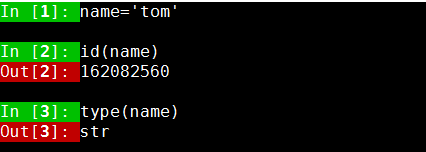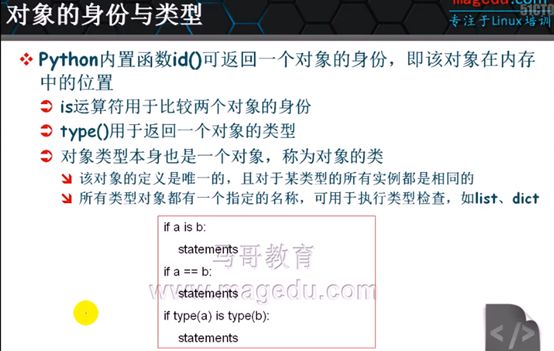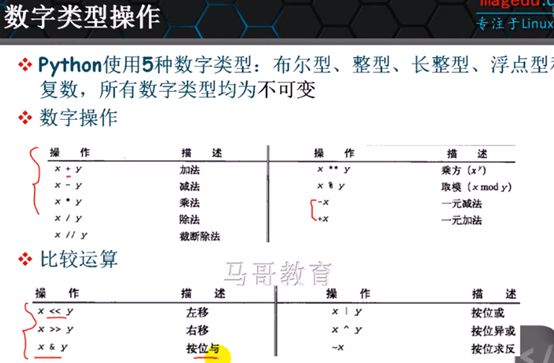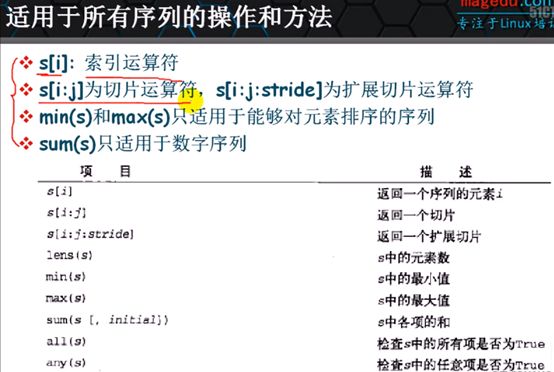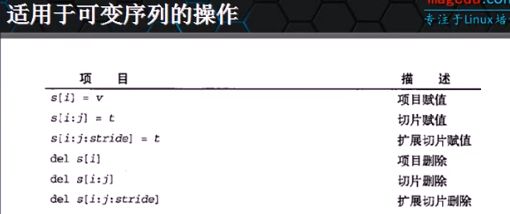python对象类型_Python(二)之对象类型
本篇记录Python对象类型
开始仍然是先掌握几个查看对象有用的函数,id,type,print
查看对象身份、类型、值:记住以下两个命令id,type
两个对象的比较
以上三个分别是 身份比较、对象值比较、对象类型比较。
核心数据类型:
数字:int,long,float,complex 复数,bool
字符:str,unicode
列表:list
字典:dict
元祖:tuple
文件:file
其他类型:集合(set),frozenset,类类型,None
其他文件类工具:pipes,fifos,sockets .....
类型转换:
str(),repr()或format()将非字符型数据转化为字符;
str输出的结果和print输出一样,repr表示程序中某个对象的精确值,format利用指定的特殊格式转化。
int():转化为整数
float():转化为浮点型
list(s):将子串转化为列表
tuple(s):将子串转化为元组
set(s):将子串转化为集合
frozen(s):将子串s转化为不可变集合
dict(d):创建字典,d是元组的序列
In [25]: list=[('a',1),('b',11),('c',111)]
In [27]: dict1 = dict(list)
In [28]: print dict1
{'a': 1, 'c': 111, 'b': 11}
chr(x):将整数转化为字符
ord(x):将字符转化为整数
hex(x):将整数转化为16进制字符串
bin(x):转化为二进制字符串
oct(x):转化为八进制字符串
In [34]: type(oct(8))
Out[34]: str
In [35]: type(bin(8))
Out[35]: str
In [36]: type(hex(8))
Out[36]: str
In [37]: type(ord(8))
数字类型:
Python的数字字面量:布尔型、整数、浮点型、复数
布尔型:True 1
False 0
高级算术函数:
In [8]: import math
In [9]: print math.
math.acos math.copysign math.floor math.log math.sinh
math.acosh math.cos math.fmod math.log10 math.sqrt
math.asin math.cosh math.frexp math.log1p math.tan
math.asinh math.degrees math.fsum math.modf math.tanh
math.atan math.e math.hypot math.pi math.trunc
math.atan2 math.exp math.isinf math.pow
math.atanh math.fabs math.isnan math.radians
math.ceil math.factorial math.ldexp math.sin
序列类型:
字符类型:
字符串字面量:把文本放入单引号、双引号或三引号中;三者并无明显区别,三引号可以跨行,‘’‘,”””
python2要保存unicode编码,则在子串之前使用字符u进行标识,如下:
In [12]: str1 = u"hello world"
In [13]: type(str1)
Out[13]: Unicode
In [21]: str.
str.capitalize str.format str.isupper str.rfind str.startswith
str.center str.index str.join str.rindex str.strip
str.count str.isalnum str.ljust str.rjust str.swapcase
str.decode str.isalpha str.lower str.rpartition str.title
str.encode str.isdigit str.lstrip str.rsplit str.translate
str.endswith str.islower str.mro str.rstrip str.upper
str.expandtabs str.isspace str.partition str.split str.zfill
str.find str.istitle str.replace str.splitlines
注意strip,[chrs] 是集合对象。
In [26]: str3="098python980"
In [27]: str3.strip('890')
Out[27]: 'python'
In [30]: str4.strip('098')
Out[30]: 'python'
In [31]: str4="0098python0009989"
In [32]: str4.strip('098')
Out[32]: 'python'
文档子串: 模块、类或函数的第一条语句是一个字符的话,该字符串就成为文档字符串,可以使用__doc__属性引用。
In [15]: def printName():
....: "test function"
....: print "hello python"
....:
In [16]printName()
hello python
#带有小括号,是调用运算符,调用函数本身
In [17]: printName().__doc__
hello python
不加括号,表示引用函数对象
In [18]: printName.__doc__
Out[18]: 'test function'
运算符:
索引、切片、扩展切面(带有步长),切面后的结果会生成的新对象。i和j支持负数。
正向是0计数,反向是-1开始计数
内置函数:min(),max()
列表:
容器类型
任意对象的有序集合,通过索引访问其中的元素,可变对象,支持异构(一个列表中包含不同类型的元素),任意嵌套
支持在原处修改:
修改指定的索引元素,修改指定分片,删除语句,内置方法。
list1+list2 列表合并,返回一个新列表,
str1+str2 子串相加,返回一个新子串
list1*N:把list1重复N次,返回一个新列表
in:成员关系判断字符,用法obj in container
not in:
列表复制:list1=list2[:]
deepcopy:
In [36]: import copy
In [37]: copy.
copy.Error copy.copy copy.dispatch_table copy.name
copy.PyStringMap copy.deepcopy copy.error copy.t
In [37]: list1=[1,2,3,4,5]
In [38]: list2=copy.deepcopy(list1)
In [39]: print list2
[1, 2, 3, 4, 5]
In [40]: id(list1)
Out[40]: 154380428
In [41]: id(list2)
Out[41]: 154128620
In [13]: list1=[1,2,3,[4,5],"y",{"x":5}]
In [14]: print list1
[1, 2, 3, [4, 5], 'y', {'x': 5}]
In [15]: list1[1]=66
In [16]: print list1
[1, 66, 3, [4, 5], 'y', {'x': 5}]
In [17]: list1[1:3]
Out[17]: [66, 3]
In [18]: list1[1:3]=[]
In [19]: print list1
[1, [4, 5], 'y', {'x': 5}]
In [21]: del(list1[1:])
In [22]: print list1
In [23]: list3=[1,2,3,4,5]
In [24]: list
list list1 list2 list3
In [24]: list3.
list3.append list3.extend list3.insert list3.remove list3.sort
list3.count list3.index list3.pop list3.reverse
In [24]: list3.append('x')
In [25]: print list3
[1, 2, 3, 4, 5, 'x']
元组:
表达式符号:()
容器类型
任意对象的有序的集合,通过索引访问其中的元素,不可变对象,长度固定,异构,
嵌套。
常见操作:
t1=()
t2=(1,)
t3=(1,2)
t1+t2、t1*N、in、not in
虽然元组本身不可变,但如果元组内嵌套了可变类型的元素,那么此类元素的修改不会返回新元组。
字典:
dict:
字典在其他编程语言中又称作关联数组或散列表;
通过键实现元素存取;无序集合;可变类型容器,长度可变,异构,嵌套。
{‘key’:value1,’key2:value2’}
{}空字典;
In [1]: d1={}
In [2]: d1.
d1.clear d1.get d1.iteritems d1.keys d1.setdefault
d1.copy d1.has_key d1.iterkeys d1.pop d1.update
d1.fromkeys d1.items d1.itervalues d1.popitem d1.values
字典复制:d2 = d1.copy()
d1.iteriteams:返回一个迭代器对象
集合:
集合:无序排列、可哈希的的元素集合
支持集合关系测试
成员关系测试
in ,not in,迭代
class set(object)
| set() -> new empty set object
| set(iterable) -> new set object
不支持:索引、元素获取、切片
集合的类型:set(),frozenset()不可变集合
没有特定语法格式,只能通过工厂函数创建
总结:容器、类型、对象
1、列表,元素,字典可以不使用续行符进行多行定义。
2、所有对象子昂都有引用计数,使用sys的计数函数可以获取引用次数sys.getrefcount(name),使用del(name),删除引用。
3、对于列表和字典都支持两种类型的复制操作,浅复制和深复制;深复制的方法可使用copy模块中的deepcopy()实现。
4、Python中的所有对象都是“第一类的”,这意味着使用标识符命名的所有的对象都具有相同状态,于是,能够命名所有对象都可以直接当数据进行处理。
5、所有序列都支持迭代
6、所有序列都支持的操作和方法:
s[i]
s[i:j]
s[i:j:stride]
len(s)
min(s)
max(s)
sum(s)
all(s)
any(s)
s1+s2:连接
s1 * N:重复
obj in s1:成员关系判断
obj not in
7、可变序列的操作:
s1[index] = value:元素赋值
s1[I:j] = t :切片赋值
del s1[index]
del s1[i:j]
del s1[i:j:stride]
